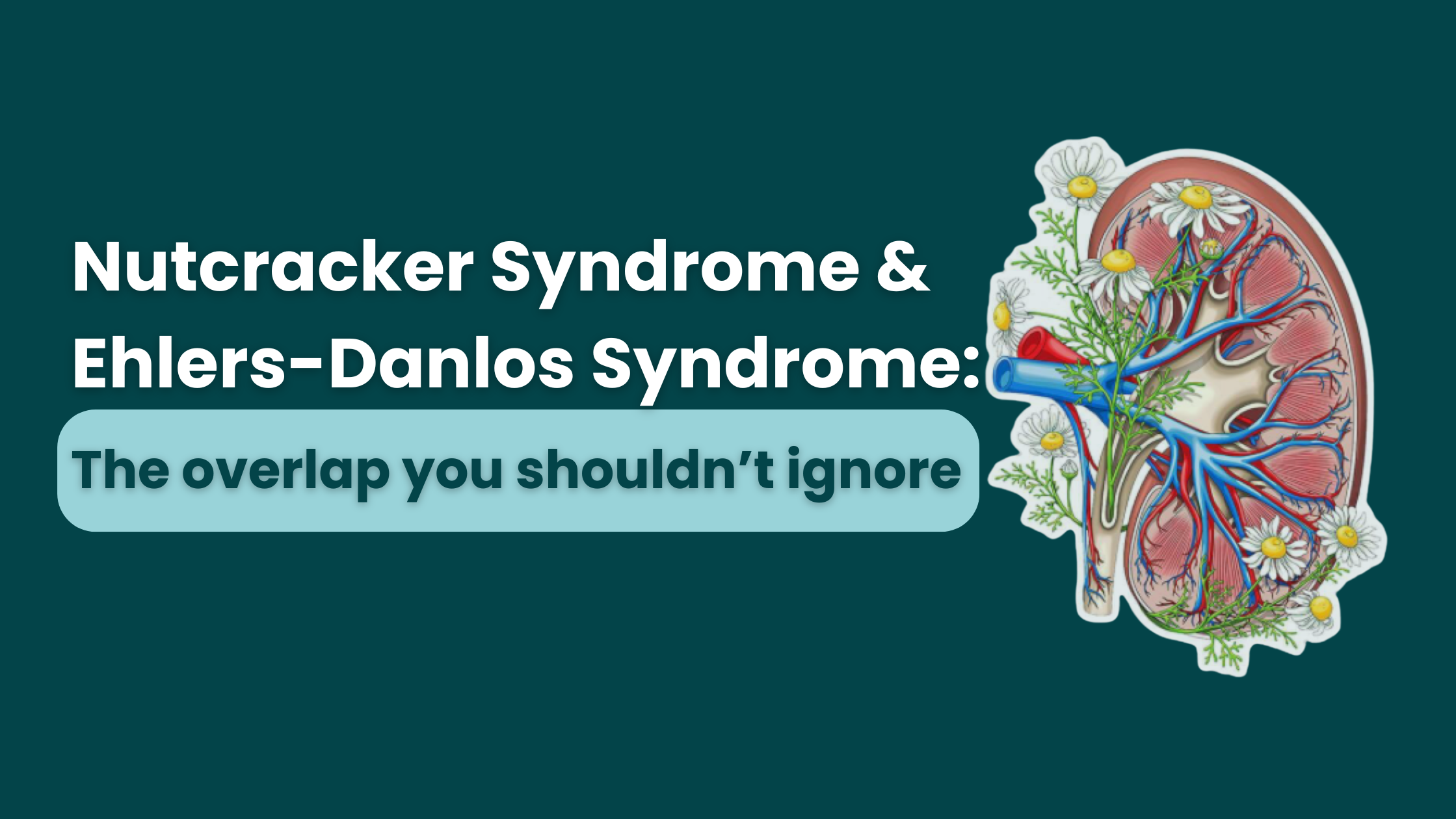Nutcracker Syndrome and Ehlers-Danlos Syndrome: The Overlap You Shouldn’t Ignore
If you live with Ehlers-Danlos Syndrome (EDS) and have been told your symptoms are “just anxiety,” “just POTS,” or “just part of being hypermobile,” this one’s for you.
Nutcracker Syndrome (NCS) is an underdiagnosed vascular compression disorder that often shows up alongside connective tissue disorders like EDS and Postural Orthostatic Tachycardia Syndrome (POTS). And while it’s not talked about enough, it should be, especially if you're experiencing unexplained pelvic pain, flank discomfort, or symptoms that seem to defy a clear diagnosis.
Let’s break it down.
What Is Nutcracker Syndrome?
Nutcracker Syndrome occurs when the left renal vein becomes compressed, typically between the abdominal aorta and the superior mesenteric artery (SMA). This narrowing causes impaired blood flow, increased vein pressure, and congestion in nearby veins.
Think of it like a nut being squeezed in a nutcracker. That “crushing” effect can create all kinds of downstream problems, especially in the pelvis.
Symptoms of Nutcracker Syndrome
Symptoms can vary, but if you have NCS, you may notice:
Left-sided flank, abdominal, or pelvic pain
Hematuria (blood in the urine) due to kidney congestion
Pelvic congestion, including visible veins in the pelvis or legs
Orthostatic intolerance (similar to POTS)—fatigue, dizziness, lightheadedness
Chronic pelvic pain, worsened by prolonged sitting or standing
Painful intercourse (dyspareunia)
Pelvic heaviness or pressure sensation
Leg swelling or aching, especially at the end of the day
These symptoms are often dismissed or misattributed, especially in people already diagnosed with EDS or POTS.
Why Nutcracker Syndrome Is More Common in People with EDS
So what’s the connection?
1. Increased Vascular Laxity
With EDS, connective tissue is weaker. That includes the tissue that supports your blood vessels. This can lead to vessel stretching, narrowing, or kinking, making vascular compression syndromes, such as NCS, more likely.
2. Anatomical Variations
Many people with EDS experience organ prolapse or shifting (called visceroptosis) due to tissue laxity. When organs move out of their typical positions, it can alter the angle between the aorta and SMA, leaving the left renal vein vulnerable to compression.
Shared Symptoms: NCS, EDS, and POTS
Nutcracker Syndrome doesn’t exist in a vacuum. It often mimics or overlaps with other conditions you may already be managing.
Shared symptoms include:
Chronic fatigue
Left-sided flank pain
Pelvic floor dysfunction (pain, pressure, urgency)
Dysautonomia
Dizziness
Gastrointestinal issues (bloating, nausea, constipation)
This makes NCS particularly tricky to diagnose, especially in complex bodies. But awareness is the first step toward clarity.
Suspect Nutcracker Syndrome? Here’s What to Do Next:
If this is all sounding a little too familiar, here are some things to consider:
1. See a Vascular Specialist
Ask specifically if they’re familiar with NCS. Not all providers are.
2. Request a Venogram
This is the gold standard test for identifying blood flow issues and compression in the renal vein.
3. Other Imaging to Consider
Doppler ultrasound
CT angiography
MR angiography
(Keep in mind: results can vary depending on your hydration status, position during the scan, and who reads the imaging.)
4. Track Your Symptoms
Start a log of your symptoms, flare patterns, and what makes things better or worse. This can be invaluable when advocating for yourself.
5. Explore Treatment Options
Conservative: hydration, compression, pelvic floor therapy, positional strategies
Surgical: Left renal vein transposition or stenting (in more severe cases)
Community support: Check out the Renal Nutcracker Syndrome Support Group on Facebook for lived experiences and practical insight
Final Thoughts: You’re Not “Too Sensitive.” You Deserve Real Answers.
Nutcracker Syndrome is real. And in people with EDS, it’s often missed, which means your pain, fatigue, or pressure symptoms may not just be “in your head” or “part of your chronic illness.”
If you’ve been dismissed, misdiagnosed, or told to just drink more water and move on… you’re not alone. Your symptoms deserve investigation, and you deserve compassionate, informed care.
Ready to Get Support?
I specialize in working with people who have EDS, hypermobility, and complex pelvic pain, and I understand how these conditions interconnect. If you're curious about whether NCS could be part of your symptom picture, or want support navigating pelvic pain and chronic illness, reach out here or follow me on Instagram @nicolepelvicot.
Let’s connect. Let’s untangle the root causes. Let’s get you answers.


